Ferdinand/Elefants
 |
| Dr. Ferdinand Porsche. |
The Porsche heavy tank entry which lost the heavy tank competition to the Tiger prototype from Henschel still went into service despite having only a very limited production run.
 |
| German "Elefant" tank destroyers on the assembly line. |
The Ferdinand has become one of the more controversial weapons of the war because there are many misunderstandings about it. Many people know the name, and that it was a failure. That isn't quite accurate. In brief, these were a Schwerer Panzerjäger ("heavy tank-hunter") of the Wehrmacht. They were built in small numbers in 1943 under the name "Ferdinand." The Ferdinands used tank hulls that had been produced for the Tiger I tank competition, but which were rejected in favor of the competing Henschel design. The name commonly used to describe them later changed to "Elefant" due to their distinctive profile.
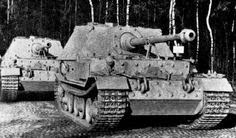 |
| Two Ferdinands on the prowl |
These initially was called Ferdinands in honor of Porsche company leader Ferdinand Porsche, but as with many German weapons systems the official and common names were quite different. It was the soldiers who later changed the name to "Elefant." The name change was more or less accepted by the Wehmracht - they were very casual about official names, it was the vehicle number that really mattered. Over time, there also was a desire to minimize Dr. Porsche's involvement, because it was not considered a major success and Hitler still expected great things from the auto designer.
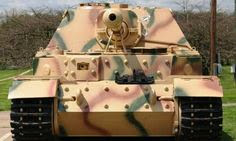 |
| A surviving Elefant at Aberdeen |
An easy way to remember the name change is that the tanks were called "Ferdinands" while operating on the Eastern Front, and then "Elefants" after being transferred to Italy. This was after the tanks were sent back to the factory and changed to incorporate a commander's cupola and machine gun, among other extra touches derived from battlefield experience.
 |
| The Porsche Tiger - a second try that also failed, but looking a bit more like the eventual winner. |
First things first: this was second a design submitted from Porsche that competed against the Henschel Tiger (after the original Ferdinand design was rejected). A prototype PzKpfw VI Tiger (P), also known as the Porsche Tiger, was never a serious contender against the Henschel Tiger - but it could have been. This second Porsche entry had superior armor, but during test trials it also proved a failure like the first: the power steering often broke, the engine overheated, and it got stuck in mud too easily (a hugely important consideration on the Eastern Front). The version was rejected and the Henschel tank chosen.
Only five of these second "Porsche Tigers" were produced before Porsche gave up. Only one saw combat, but the design did not go completely to waste. Later the chassis design for this second version was used for the Elefant/Ferdinand tank destroyers that did enter combat.
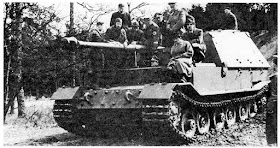 |
| Dr. Porsche, front left fender, during a test ride of the Ferdinand. |
So, the Ferdinand had a kind of hybrid, accidental, extended development. In the end, it worked out well, perhaps not as a perfect tank, but certainly a useful vehicle that out-performed its limited expectations.
Only about 88 Ferdinands were made (some sources say 90, the exact number is difficult to pin down), and all were used at first in the northern sector (von Kluge and Model's sector) of the Kursk battle. The Soviets feared the Ferdinands and made special note to look for them and adopted specific ways to attack them. However, the Soviets were looking in the wrong place.
 |
| Elefant of the Schwere Panzerjäger-Abteilung 653. The batallion crest - The Nibelungen Sword (on the turret) |
The Soviets wrongly thought that the Ferdinands would be in the southern (Generals Manstein and Hoth, along with SS General Hausser) wing of the Kursk attack. In fact, that pincer had none. This fear factored into the Soviet battle plans and deployments, an example of "psyching out" your enemy before the first gun is fired. Soviet after-action reports repeatedly cited the Ferdinand on the southern sector when in fact the opponent had been a Stug, a Marder or some other vehicle with a vaguely similar profile. Its notoriety on the Soviet side was enormous, its actual effect on the Eastern Front in a battle sense minimal.
 |
| Elefant captured by the Soviets (see below for explanation). |
General Model had no success in his northern sector at Kursk despite having all the Ferdinands. His offensive was stopped cold after a minor breakthrough at a well-defended ridgeline. He then had to fight for his life to avoid encirclement. Since the Ferdinand was supposed to be a cornerstone of this prong of the offensive, it developed a bad reputation early on. It certainly is true that it was an enigma of a weapon. The Ferdinand was prone to breakdown, caught on fire frequently, was slow and had no defensive machine gun. As such, in poorly supported offensive roles against heavy defenses such as Kursk, the Ferdinand was a disaster.
 |
| New Elefants |
Many were destroyed before even reaching the front line by mines and breakdowns and the like. That actually is fairly common for a new tank. In addition, when a Ferdinand outran its infantry support it was doomed. Alan Clark in his book "Barbarossa" makes the Ferdinand sound like an Edsel. As he notes, with no secondary armament the Soviets could run over and attach mines to it, pour gasoline into the engine, or use various other simple tricks to knock them out when there weren't any panzergrenadiers around.
 |
| Date and location unknown |
So, some 39 were lost in Kursk (again, sources vary), many to mines, others to Russians sneaking up on them. Once disabled, Ferdinands were sitting ducks later for air attack or artillery. They were heavy and thus required special equipment to tow. On a fluid battlefield which the Germans were forced out of, that was seldom possible. More than one was blown up by its own crew to avoid capture.
The breakdowns and so forth didn't happen nearly as often as later legend would suggest. That it could and did happen at all was not a good sign for the Ferdinand, of course. Tanks that couldn't operate independently, such as a Henschel Tiger, required a lot of support. This was hard to come by in offensive operations such as Kursk, and increasingly rare as the war went on.
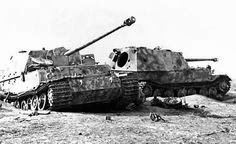 |
| Destroyed Ferdinands |
 |
| Elefant, rear view. Somewhat vulnerable to an antitank gun with that flat panel - don't turn your back on the enemy |
Legend has it that Ferdinands destroyed 355 enemy tanks for every Ferdinand lost (a more conservative guess is 10:1, which is still the best ratio for a class of tanks in history). Some would argue that this makes the Ferdinand/Elefant the most successful tank killer of the war. That's certainly a better ratio than the fabled Tiger. Note that in Italy, the Elefant was no longer facing T-34s or Stalins, it was only up against tin-can Shermans. So, all figures must be taken with a grain of salt for numerous reasons.
The fact that the Ferdinands were withdrawn from the Russian Front made many later authors assume that they were complete failures. That is far from the truth. Hitler also intended to transfer other formations to Italy at the same time because of the Allied invasion of Sicily. These transfers did not signify failure; in fact, Hitler chose elite formations such as the Leibstandarte Division to shore up the Italian defenses. In any event, the Ferdinands were handy and ready to ship to Italy, plus the forces in Russia were not in love with them, so off they went.
 |
| Elefants on the move |
The transfer worked out particularly well for the Ferdinands (now called Elefants), because the mountainous and woody terrain of Italy, plus the availability of ample infantry, was ideal for their deployment as defensive tank killers.
Air attack also was not as much of a problem in the Italian mountains as opposed to the flat, featureless Ukrainian plains. In addition, the tight western Europe railroad and road networks were better for the bulky beasts to move around to decisive points where they were most useful. The Italian defense was localized and had all sorts of convenient choke points, perfect for a massive weapon like the Elefant which could sit back under cover and blast away.
 |
| This color shot shows the camouflage of the time. A column of Tigers heading toward the front in France |
Despite their record of success, production of the Ferdinand was never restarted, perhaps because Porsche now was busy with the even larger (and truly ridiculous) Maus. However, if imitation is the sincerest form of flattery, the Italians flattered the Elefant by designing their own tank destroyer, the Semovente 105/25, that had a somewhat similar silhouette with a stronger main gun. If nothing else, this confirmed the wisdom of using the Elefant in the mountainous territory of Italy, where they weren't as conspicuous, rather than the featureless Russian steppes.
The Elefants did their job in Italy, but they were big targets and they weren't building any more of them. Eventually, all were knocked out or broke down/ran out of gas and left behind on the battlefield, to be taken to the scrap yard during and after the war. Only two survive, one in Moscow, the other in Virginia. The bottom line is that this is one weapon that may have profited the Germans if they had built more.
What Might The Ferdinand/Elefant Look Like Today?
The Ferdinand/Elefant gets a bum rap in many quarters due to its being passed over in favor of the Henschel Tiger. The implication is that the Ferdinand/Elefant was a failure and mistake. However, that view is unfair, because the Ferdinand/Elefant was a valuable weapons that gave good service once used properly (in a defensive role with adequate support). The Ferdinand/Elefant was a prescient design that remains alive today through imitators.
Rather than go through an exhaustive list, I'll just give an example. The NORINCO PLZ-45 is a Chinese self-propelled howitzer (155mm / L45 howitzer) developed for both the home and export markets in the 1990s. It is based in part upon technology obtained from Austria in the 1980s, so there may indeed be a direct link to the Ferdinand/Elefant. Regardless of any such connection, the similarities between the two weapons can be taken in at a glance. Draw your own conclusions.
 |
| PLZ-45 self-propelled howitzer. |
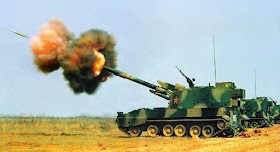 |
| PLZ-45 self-propelled howitzer. |
The Chinese PLZ-45 remains in service in Algeria, Kuwait, Saudi Arabia and China itself.
Some More Photos
There are a lot of photos of Ferdinand/Elefants despite their limited production run. Below are additional photos.
 |
| The surviving Ferdinand taking a ride |
 |
| A Ferdinand in Russia |
 |
| The surviving Ferdinand in Virginia |
 |
| Remannts of a German Elefant tank destroyer in the streets of Naples / Italy |
 |
| German troops (note the MG42) passing a knocked out Elefant, March 1944 (Koch, Federal Archive). |
 |
| Nice profile shot of a Ferdinand (and its dead crew). Note the vision slits and headlights on the hull front corners, and the flat commander's hatch |
 |
| Another rear view shot |
 |
| Gone but not forgotten |
2014





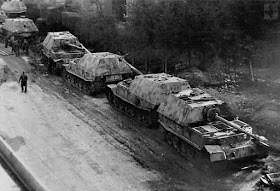


"tin can shermans"? actually even soviet soldiers said the sherman kept more rounds out than the T-34...
ReplyDeleteThe T-34 had 40-45 mm armour all around with very few exceptions. The Sherman had 30 mmm except in the front. More importantly, the T-34 introduced sloped armour, while the Sherman was a very upright tank. THe sloped armour made the T-34's protection even greater.
DeleteThere is a reason that the Germans, who had absolutely no love for the Russians, admired the T-34 and found the Sherman to be a bit of a joke. Von Kleist called the T-34 "the finest tank in the world." I defy you to find any quotes by German tank experts like that about the Sherman.
The Soviets issued their lend lease Shermans to their elite tank units.
DeleteI guess they knew something you don't...
I have absolutely no dispute that the Red Army knew a LOT about tanks that I don't know. The Germans did, too. The tank designers at Chrysler, the British tankers - all brilliant. I would certainly hope so, given that their lives depended on them.
DeleteThe Soviets used their equipment differently than the other powers. They used what they had - they had plenty of men. Quality really didn't matter, though they made excellent tanks and other equipment.
There is absolutely no evidence that the Soviets thought that Shermans were better than their own tanks, or even as good as them. The Soviets got 4102 spanking new Shermans for free and used them - anyone would. I certainly would. The Red Army put the upgraded M4A2 76w tanks into Guards units alongside T-34s, sure. They did not "prefer" Sherman tanks, they basically just treated the Sherman tanks as "good enough" and filled open tank slots with them. Soviet soldiers took whatever they were given by the bureaucrats, just like many Soviet pilots flew biplanes throughout the war.
The Soviets also used the P-39 and P-40 that they got via Lend Lease extensively, too. They basically used whatever they were given by the generous Allies. Their own fighters such as the Yak-9 and La-5 were good enough, but WWII was as much a battle of attrition as anything else. Just because they used the P-39 and P-40 fighters, though, does not mean they were terrific fighters.
The Soviets who visited US factories and had a choice in the matter rejected the M3 and the M4A4. They didn't particularly like many Allied tanks. The Sherman just happened to be the best tank the Americans had, and they were the ones giving them for free. Anyone would take the best car they could get for free, even if it isn't a Porsche racecar. A Chevy would do just fine.
This is a controversial subject and opinions differ, but interpreting Soviet use of these tanks in their Guards units as meaning they thought the Sherman tanks were great and the equal of their own tanks is absolutely unsupported. They used what they had on hand, filled open slots with them rather than let units get run down, and had no qualms about sending their men out in whatever. That was an attitude the Soviets displayed throughout the conflict. The Soviets were not particularly mindful of treating their grunts like kings, and riding a Sherman was certainly better than walking through the mud. For an army that intentionally would send out poorly armed new recruits in opening attacks simply to make the Germans expend ammunition, knowing they would get slaughtered, worrying about qualitative differences of tanks was not a priority.
Well, I'm sorry to disappoint you, but the Sherman was actually a much better tank than the T-34, and that's why they were given to elite units exclusively.
ReplyDeleteThe T-34 is probably the most over-estimated tank in history.
It all started when the Germans first invaded Russia and their PzKw III and PzKw 38t tanks, which were mainly armed with a 37mm AT gun, proved incapable of handling the simply much heavier T-34.
During the war Soviet propaganda further inflated the legend, and when the war ended the Soviet Union was in such a deplorable state that “maskirovka” went into overdrive to fool the West into believing the Soviet Union was much more military powerful than it really was.
And in the West self proclaimed “armoured warfare specialists”, who in reality probably wouldn't have been able to distinguish a drive sprocket from a turret hatch, parroted all this rubbish faithfully, creating a false image of the T-34 that would survive into our time, to be nowadays sold as fact by other publishers of questionable accuracy, like “the History Channel” for instance.
The truth is that the T-34 was a real death trap, something their disastrous loss-rate alone already proves beyond much doubt; Soviet industry produced almost 65,000 T-34's during the war, and was still barely capable to keep up with losses.
The T-34 was a flawed design, manufactured in a shoddy way, and the only reason the legend build around it survived is that the Soviet Union (barely) managed to win the war.
If you want to know what it's many flaws exactly were just say so, I'll be happy to enlighten you.
Totally agree.
DeleteFrans you have no idea what yourtalking about! Do some reading before you start making wild claims.
DeleteThe Russians used the M4A2 Sherman tanks because they could run on one engine and were a lot quieter than the T34. That way they could get closer to the German infantry. the German infantry would use the Panzerfausts and PanzerShreks to destroy Many T34s. The T34s were sent in to battle carrying infantry but they couldn't hear anything wile riding on the tanks. Also the M4A2 ran on diesel like the T34's and could go along way before breaking down. The Sherman's had lots of problems but they were reliable. they had to be designed for ship transport to Europe so they were limited on armor and because of the aircraft engines were very tall. They also had two major advantages over the T34, They all had a good radio and they had a very good field of view vs all models of the T34.
Delete